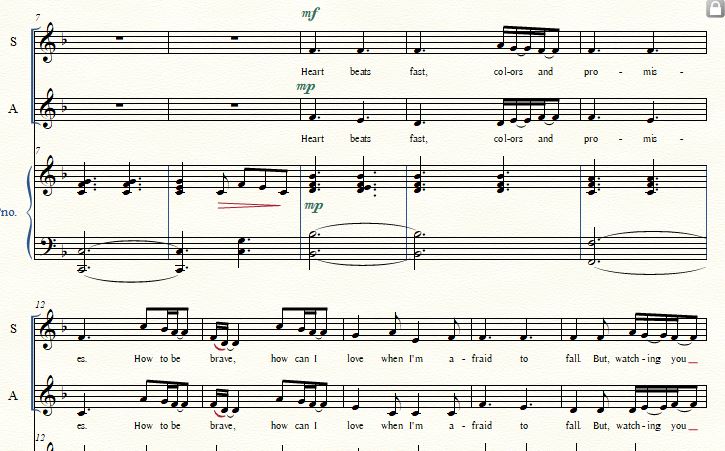Crafting Choral Compositions That Sound Complex, But Aren’t

Composing and arranging for a choral group presents a unique challenge – creating a piece that sounds intricate and compelling while remaining approachable for singers. Striking this delicate balance requires a thoughtful approach to melody, harmony, and vocal techniques. In this article, we will explore ways to compose or arrange a choral piece that sounds complex but doesn’t overwhelm the performers, ensuring an enjoyable and engaging experience for both singers and audiences.
1. Know Your Voices:
This is important for both composing and arranging for a choral group. Understanding the vocal range and capabilities of the choral group is fundamental to crafting an accessible yet intricate composition. Consider the choir's skill level, the number of vocal parts, and the range of each section. Tailor your piece to showcase the strengths of the ensemble while providing challenges that elevate their performance.
If composing or arranging for a particular group, keep in mind that the members of that group continually change. A particular part written for a certain group of more highly skilled singers that exists this year may be unsuitable for the same part next year. For example, a tenor part that goes to a high Bflat ( an unusual high note for high school age young men) that was written for this year’s ensemble will likely be unsingable in a year or two.
2. Create Imaginative Melodies:
For composing, start by developing a captivating and memorable melody that forms the foundation of your piece. While you want to create an impression of complexity, simplicity in the main melodic line will resonate with both singers and listeners. Avoid overly elaborate vocal lines that might hinder singers, focusing instead on melodic ingenuity.
Some things to consider when creating for a great melody:
> It should have some motion to it. A note can be repeated a few times for stability or preparation for some other movement, but if the same three notes are repeated over and over, it doesn’t leave much room for creativity in a choral composition.
> The average range for each part should leave a little room for what might be called a “severe escape tone”. That is, it should allow for a wider than normal skip so that some major emphasis can be added to the piece.
> Consider a modal insertion. A modal insertion is the placement of a chord in a progression that is not in the normal set of chords for that key, and which functions as a chord in an old church mode. For example, in the key of C, the primary six chords are C, F, G, A minor, D minor and E minor. None of these chords needs an accidental. A sample progression would be C – Am – F – G – F – G – C – C. A sample progression with a modal insertion would be C – Am – F – G – Bb – F – C – C. The Bb chord makes the progression sound like a Mixolydian mode progression.
> Consider using a secondary dominant, especially a well-disguised one, they have more impact. The most notable use of secondary dominants is in traditional gospel music, and the raised fourth ( an F# note in a D chord in the key of C) is often sung to point up the chord. If the secondary dominant is used, but the melody passes through the root, fifth or even the seventh note of the chord, it softens the brightness of the chord while still adding color to the melody.
For an arrangement, it may take some searching to find a piece that has a great melody that’s well suited for a choral group. Many pop tune melodies are carried by the band’s accompaniment, and the singer’s presentation, and not by the quality of the melody itself. The guidelines for composing a melody also apply here, plus one. A song that offers the opportunity to use alternate chords helps with creating more interesting harmonies.
3. Choose an Appropriate Key:
For composing and arranging, it’s important to choose a key that not only matches the ability of the choral group, but enhances the feel of the song. A high-powered song should be in as high a key as the choral group can handle. A softer song such as a love song or funeral song, should be in a lower key. Also, be sure to consider the accompanist and use a key that is playable by most school accompanists, many of whom may be students. If you choose the key of B, many accompanists will have a hard time playing it. You can move it a half step one way or the other and make it easy to play without compromising the sound of the choral group.
4. Create Harmonic Depth with Simplicity:
For both composing and arranging, weave harmonies that add depth and sophistication without becoming overly intricate. Strategic use of consonant and dissonant intervals can create a rich harmonic tapestry. Ensure that the harmonies complement the melody and enhance the overall emotional impact, contributing to the illusion of complexity. Here is a sample from a Salt cellar arrangement of “A Thousand Years” by Christina Perri. Notice that the alto part slowly “peels away” from the repeated noted notes in the soprano part. Then, the alto part makes some counter-motion to join the soprano note again.

The goal is to make the harmonies as much like a second melody as possible, particularly in the alto and tenor parts. Don’t be afraid to occasionally allow the alto and tenor parts to “cross”. It can add interesting color and texture.
5. Layered Textures:
Again, for both composing and arranging, introduce layered textures to add complexity to your choral composition. Utilize polyphony, homophony, and antiphony to create interplay between vocal sections. This layered approach gives the impression of intricate musical architecture while allowing singers to navigate their parts with clarity. Sometime this is a simple as having one part start a phrase a half or whole beat ahead of the rest. Here’s a sample from the Salt Cellar arrangement of “He Who Would Valiant Be” by John Bunyan.

Notice that, in the second measure, the altos and basses come in a half beat before the others. That adds just a bit of punch. In the third measure, the tenors and basses do the same. Because the voicing in the third measure uses lower voices, the punch is just a bit harder.
6. Play with Dynamics:
Dynamic contrast is a powerful tool in crafting complexity. Experiment with gradual changes in volume, building tension and excitement throughout the piece. Dynamics not only enhance the expressive qualities but also contribute to the illusion of a challenging musical landscape.
Dynamics in choral music can also be somewhat explosive, creating instant excitement. However, this is somewhat rare. In contrast, they can also gain attention by becoming suddenly quiet (subito piano). Some teachers use whispering to gain a class’s attention. The same can apply to music.
Often, dynamic changes in choral music are accomplished by gradual crescendo or decrescendo across the parts. However, this can also be achieved using a terraced dynamic effect in which parts are added or subtracted with the same dynamic marking as the parts already there. This creates a built-up dynamic change.
Below is an arrangement by Salt Cellar of The Call from the Narnia movie “Prince Caspian”. This section contains two dynamics changes. The first is the addition of the Alto and Bass parts to the Soprano, all at a piano dynamic (terraced dynamics). Then, all the parts do a crescendo to a forte. It’s almost explosive, but not quite.

7. Rhythmic Nuances:
Incorporate rhythmic nuances to add flair and interest to your choral composition. Experiment with syncopation, varied time signatures, and unexpected rhythmic patterns. However, be mindful of the singers' ability to execute these rhythms, ensuring that the complexity enhances rather than hinders the overall performance.
8. Vocal Techniques and Effects: Explore the diverse palette of vocal techniques and effects available to choral composers. Introduce techniques such as vocal percussion, cluster chords, or extended vocal techniques to create moments of intrigue. However, use these sparingly and thoughtfully to maintain accessibility for the performers.
9. Articulation and Diction: Pay close attention to articulation and diction to enhance the clarity of the text. Experiment with different vowel sounds, consonant emphasis, and varied articulation markings to add nuance to the vocal delivery. Clear enunciation ensures that even complex lyrics are effectively communicated to the audience.
10. Collaborate with Choir Directors: Engage in collaborative discussions with choir directors throughout the composition process. Seek their insights on vocal capabilities, rehearsal considerations, and the preferences of the choral group. This collaboration ensures that your composition aligns with the strengths of the ensemble and enhances their overall performance experience.
Conclusion: Crafting a choral piece that sounds complex yet remains accessible demands a harmonious blending of creativity, technique, and consideration for the singers. By knowing your voices, embracing inventive melodies, incorporating harmonic depth with simplicity, experimenting with layered textures, playing with dynamics, introducing rhythmic nuances, exploring vocal techniques and effects, and prioritizing articulation and diction, you can compose a choral masterpiece that captivates both performers and audiences alike. Let your musical creativity flourish as you navigate the delicate balance of crafting complexity within the harmonious realm of choral compositions.
Salt Cellar Creations understands and possesses the knowledge and skill to write and arrange for not only choral groups, but also concert band, string orchestra and others. We have a growing library of original works and arrangements. Find out more about what Salt Cellar Creations has to offer for Choral Ensembles HERE. Explore the available music HERE.
SCC can also compose an original piece for you or do a custom arrangement for you. There are two ways that this can be done; one is much more affordable than the other. And SCC is always looking for ideas of pieces to arrange or suggestions for original pieces.
We have sold music not only in the US but in Canada, the United Kingdom, France, Australia, New Zealand and Austria. Please visit the WEBSITE or CONTACT US to let us know what we can do for you!